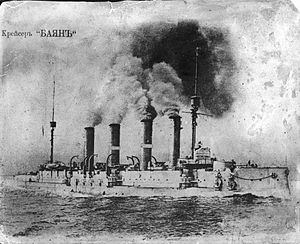 A postcard of Bayan at sea
| |
| History | |
|---|---|
| Name | Bayan |
| Namesake | Boyan |
| Builder | Admiralty Shipyard, Saint Petersburg, Russia |
| Laid down | 15 August 1905[Note 1] |
| Launched | 15 August 1907 |
| Completed | 13 December 1911 |
| Fate | Sold for scrap, 1922 |
| General characteristics | |
| Class and type | Bayan-class armored cruiser |
| Displacement | 7,750 long tons (7,874 t) standard |
| Length | 449.6 ft (137.0 m) |
| Beam | 57 ft 6 in (17.5 m) |
| Draught | 22 ft (6.7 m) |
| Installed power |
|
| Propulsion |
|
| Speed | 21 knots (39 km/h; 24 mph) |
| Complement | 568 |
| Armament |
|
| Armour |
|
Bayan (Russian: Баянъ) was the third of the four Bayan-class armoured cruisers built for the Imperial Russian Navy in the early 1900s. The ship was assigned to the Baltic Fleet. She was modified to lay mines shortly after World War I began. Bayan laid mines herself and provided cover for other ships laying minefields. The ship fought several inconclusive battles with German ships during the war, including the Battle of Åland Islands in mid-1915. She also participated in the Battle of Moon Sound during the German invasion of the Estonian islands in late 1917, where she was damaged. Bayan was decommissioned in 1918 and sold for scrap in 1922.
Cite error: There are <ref group=Note> tags on this page, but the references will not show without a {{reflist|group=Note}} template (see the help page).